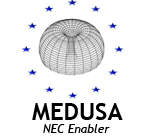Multi Sensor Data Fusion Grid For Urban Situational Awareness
Funding programme: EDA European Defence Agency
Start – end year: 2009 – 2011
Partnership
AGH University of Science and Technology, Department of Telecommunications, Poland
Athens Information Technology (AIT), Greece
Centre of Research and Technology Hellas (CERTH), Greece
Data Fusion International, Ireland
CS Systèmes d’Information (CS), France
INDRA Sistemas, Spain
French-German Research Institute of Saint-Louis (ISL), France
PLATH GmbH, Germany
Computer and Automation Research Institute Hungarian Academy of Sciences (SZTAKI), Hungary
Universität der Bundeswehr München (UniBwM), Germany
VITROCISET S.p.A. (VCS), Italy (consortium leader)
Consorzio Milano Ricerche (acting as subcontractor)
The project
The overall goal of the MEDUSA Project is to realize a robust, high-performance, integrated, intelligent, autonomous and versatile multi-sensor data fusion grid (SFG). It will significantly improve Situational Awareness (SA) and Command and Control (C2) in the context of Force Protection (FP) in urban environments also including visualization through a comprehensive Operational Ground Picture (COP).

The approach of the project is designed to address an already acknowledged capability shortfall specifically in the area of: fusion of multiple – as opposed to individual types of information – relevant to force protection in urban environments.
In addressing this subject, an extensive MEDUSA project team has been assembled to consolidate a range of skills and disciplines that will allow specialist work to be performed comprehensively:
- Addressing a range of sensor types inclusive of acoustic, video (inclusive of visible and infra-red bands), magnetic, motion detection, CBR and ‘through the wall’ radars. Additional focus will be placed on ground soldier wearable sensors, thus enabling participants to become both producers and consumers of fused, dynamic information relative to their position – and the passing of this SA information across a hierarchical C2 structure;
- Enabling fusion of multi-sensor data with contextual information and in particular with 3D GIS and digital terrain data;
- Developing new algorithms improving the effectiveness of existing single sensor inputs in terms of data accuracy, time correlation and sensor coverage, as well as resolving ambiguities generated in the process of multi-sensor data fusion;
- Improving algorithms enabling automatic detection, recognition and tracking.
The activity of CMR is focused on the following points:
- Development of components of the framework for the uniform representation of data and reasoning with temporal notions.
- Implementation of techniques for sensor data analysis and sensor fusion.
All the above will be developed within a novel MEDUSA Sensor Fusion Grid which will allow improved situational awareness and decision support in the C2.
In addition, the project incorporates the development of a ‘prototype’ which clearly demonstrate the various technology deliverables and will illustrate, among the others, a capability for users to select various combinations or ‘sets’ of sensors and associated contextual information types.
Thus the MEDUSA project inherently enables the linking of improvements and advancement of TRLs in data fusion per se, the associated algorithms, the sensor network and summarily giving rise to enhanced urban environment forces protection and SA superiority.
Given the nature of this project and its approach, it is felt that there will likely be exploitable synergies with the outputs of several of the other EDA FP-JIP Call 3 Data Fusion projects – thus enhancing the MEDUSA project in terms of overall value proposition and potential return on investment.
